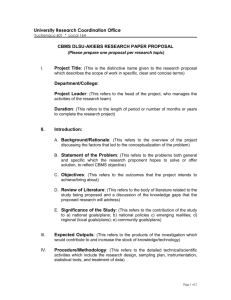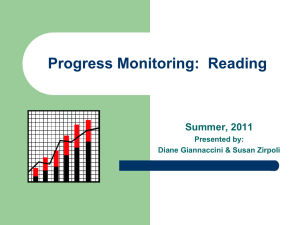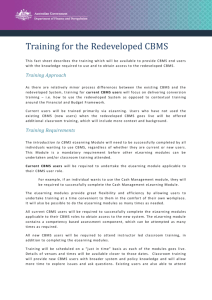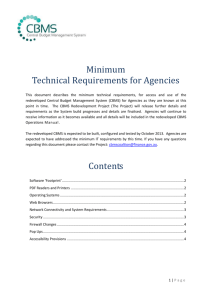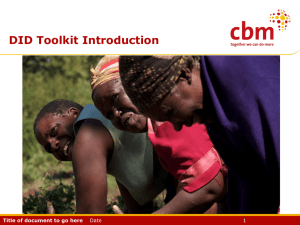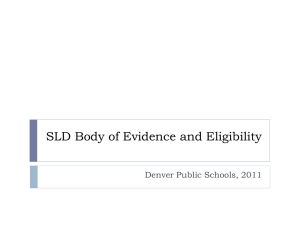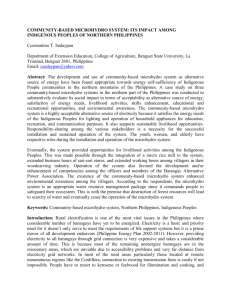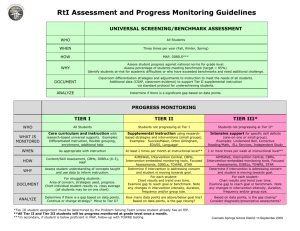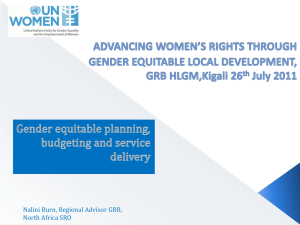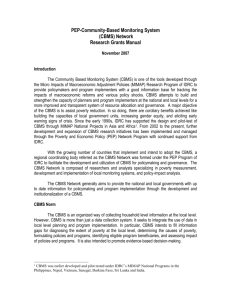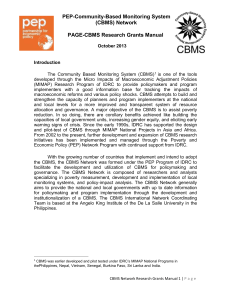Project%20Coast%207
advertisement
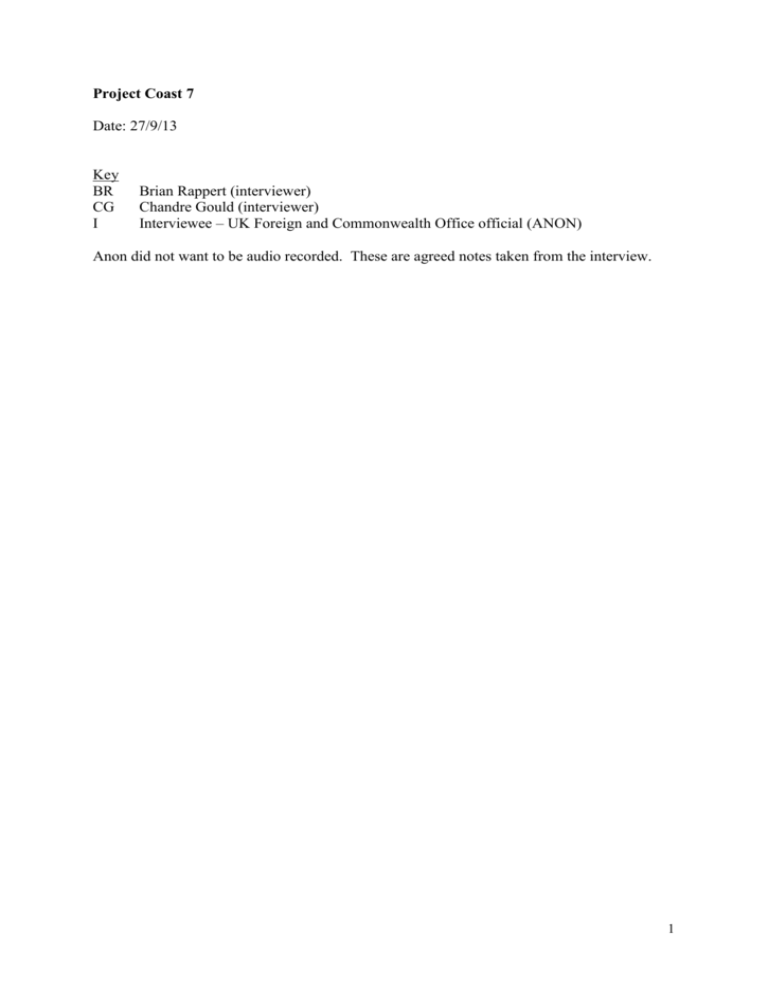
Project Coast 7 Date: 27/9/13 Key BR CG I Brian Rappert (interviewer) Chandre Gould (interviewer) Interviewee – UK Foreign and Commonwealth Office official (ANON) Anon did not want to be audio recorded. These are agreed notes taken from the interview. 1 CBMs have their origins in the 2nd Review Conference; they were an attempt to strengthen the BWC by dealing with compliance problems in a preliminary way. Another early (1980) major impetus for CBMs was the Sverdlovsk anthrax outbreak – a leak caused by an accident at a Soviet BW production facility. The object and purpose of CBMs can be seen in the 1986 Stockholm Conference on Disarmament in Europe (CDE); a series of CBMs on notification, observations and inspection of military exercises was agreed between NATO, Warsaw Pact and neutral states; an earlier antecedent was the1975 Conference on Security and Cooperation in Europe seeking to reduce the risk of surprise attacks through declaration mechanisms and the 1958 Conference on the Prevention of Surprise Attack. What was looking achievable in the 1986 CDE Conference helped create a climate for agreement on CBMs at the Second Review Conference. Purpose of CBMs to promote transparency and openness about what is happening ‘on the other side’; enable ways of identifying the dogs that did not bark – for example absence of any publications from suspect military biological facilities could be indicative. Two important issues to be declared: high containment laboratories and unusual out breaks of infectious disease – the Sverdlovsk incident. The later CBM F on past offensive/defensive BW programmes was needed because to have confidence in the future you have to understand the past. CBMs provide narrative that can be checked against other sources of information. When CBMs formulated for the BWC in 1986/7 and revised in 1991it was not clear how they were meant to be used in practice. The starting point for declaring past programmes under Form F (agreed in 1991) was 1946, so as to draw line under activities of WWII, and so as not to embarrass Japan for its wartime activities (Unit 731). This cut-off date was borrowed from the draft CWC. Expectation with HMG that the USSR would lie within its CBM F reports. But, transparency of CBMs was still considered to be one way of gaining insights into the USSR programme. The policy to constrain Soviet capabilities relied on increasing predictability. Form F was sold to USSR as a way of getting information about Western governments and those serving collective security overall. The idea was that if the gap between our intelligence and the CBM report was too big that would tell us about motives and intent and offer a barometer for assessing the seriousness of the state (Soviet in particular) on dismantling its offensive VW programme . Form F of the CBMs was seen to be important and effective, even though information contained in them is not likely to be reliable because they provide a basis to hold states to account. They also provide a barometer for assessing whether or not states are serious about the treaty, because by testing the information in CBMs against what is already known, it is possible to determine the extent of disclosure/concealment. For study of importance of CBMs see Confidence Building in the Arms Control Process by James Macintosh. South Africa ANON not a direct participant in the initial UK-US-RSA discussions with RSA about its CBM programme, so second-hand account. Important for HMG at that time: knowing what took place, what information was generated by the programme, what has happened to information, whether there was any proliferation to Libya, what assurances could RSA offer about control of individuals (particularly Basson who was known to be traveling to Libya). The main concern was proliferation of information to other states or terrorists. 2 Some discussion in HMG on whether assassination programme counted as an ‘offensive’ BW programme. ANON argued it was. What was important was that the programme was tiny and insignificant in comparison to the Soviet programme. And since it was only intended for attacking the ANC and supporters it was not seen in the same light as the Soviet/Russian offensive programme. Offensive as far as the BWC is concerned, is largely perceived as offensive use of weapons against other states. RSA CBM seen as economic with the truth within HMG, but this did not rattle cages in the UK. No appetite within HMG to challenge RSA about declarations for these reasons: turnover of staff a problem (there was a change of personnel and so the first-hand knowledge of it was largely lost in succeeding years Soviet/Russia CBM situation much more of an issue (why hassle South Africa if not do so for USSR?) RSA seen as reforming enough: info from programme under control, Basson under control, formation of NPC and enactment of export controls RSA constructive in Protocol negotiations (ANON and BS with Tibor Toth were the primary authors of the Protocol), so there was no appetite to rattle the cage. Between April 1994 and October 1994 there was (very) partial openness from the Soviets. The Russians had an easy way out, they could have used the end of the Soviet era as a basis for more transparency and openness but didn’t take it. South Africa did take that out. There was a clear contrast between the way the Soviets approached it and the way the South Africans did. The openness displayed through the TRC meant that Form F didn’t have to be dealt with as a major issue. This was never a formal policy decision; more of a subconscious was of operating. Non challenge of declaration did and did not undermine the purpose of CBMs. They should be comprehensive, but in the end who is reading them? RSA small potatoes in many regards. Many states do not produce good quality Form F. While not formally stated anywhere, sense that the Russia CBM as point of contrast to RSA was important in the mid-1990s. Concerns about whether the Russians were serious about change and about the BTWC: many people from the programme remained in key positions (e.g. the Surgeon General in SA retired whereas the head of the Russian programme remained in his position – General Kalinin, Head of Biopreparat); and the Form F was unbelievable. The nature and extent of the USSR offensive programme was also downplayed by the Russians in the trilateral process, whereas the South African state allowed the TRC to deal with the CBW programme. In 1996 the trilaterals with the Soviets broke down. Would the handling of the RSA CBM be different if the USSR programme had not been an issue at the same time? ANON speculates that there was a wider set of international political developments at the time, arms control only one facet of relations. The ANC government was highly supportive of arms control and disarmament (in the lead up to the NPT Extension Conference in 1995), so wider politics might have meant the Form F declaration was not very important. This was really just a small issue. This would have acted against a challenge of the CBM F. In short, the RSA was saying and doing all the right things. Lack of RSA Form F not a matter of discussion in UK or Geneva since the mid-1990s; no one brought this up as an issue. 3 UK updated its CBM Form F because it wishes to set a positive example for other states. Would RSA lose credibility if it declared its programme now? ANON thinks that SA wouldn’t lose more than it would gain at this point. UK would welcome it. It would be seen as a positive move. Maybe it would also open an opportunity to pressurise (prod) the Russians. But actually it would probably get very little attention. Turnover in BWC means that there is a tendency for conservatism: no prior knowledge or experience leads to greater caution and has a dampening effect on movement, if no one is pushing, then there is not much incentive to take up issues. Individuals also play an important role, the absence of champions slows the process down. While an incorrect Form F does absolutely undermine the purpose of the forms, which is to promote transparency, very few people actually read these things and there is no forum for discussing the CBMs anyway. Reasons why SA might not have changed the form could have included the fact that they are not used. Since no one knew about the programme, why bother to change it? The SA CBM F is simply not an issue. RSA is one of the few states that trying to do anything about the CBMs (to improve them). Does it undermine the CBMs if South Africa doesn’t declare its past programme fully? Not many people know about the history of the SA programme. Most don’t read CBMs. There would be no sharp intakes of breath. It may be cynical, but since South Africa is the only NAM country being constructive – while we should not turn a blind eye – we can be more accommodating. For most states CBMs are not about compliance to with the BWC (though the UK disagrees). But many states will parrot the 1986 Rev Con statement about the purpose of CBMs. Diplomacy is in some respects a sordid business. The strict application of principle doesn’t apply. Other issues come along and become the issue of the hour, displacing earlier, less pressing issues that take on less importance. Like Syria now. You only really have the capacity to deal with the here and now. Has the SA non-declaration of the past programme ever come up for discussion? No never. The SA programme revelations came along at the time of VEREX and UNSCOM in Iraq. And there were lessons being learned from Iraq and Russia that shaped UK approaches to the issues under discussion in the Protocol negotiations, that was the big issue, not the South African programme. In 1995 we were involved in the protocol discussion and no other delegation ever came and declared concern about the South African declaration – other than the US. There was much more interest in the trilateral discussions with Russia. At the Fourth Review Conference in 1996 Pakistan complained about the discriminatory treatment of Iraq over its programme whilst nothing was said of the Soviet/Russian one . SA were the good guys, you don’t want to beat up on your friends. But at the same time, this is not something that is conscious and consciously discussed. It’s not a matter of a formal policy decision adopted by Ministers. Inaction Map Reaction to the inaction map: This is very good. Inaction is a constant problem in relation to the CBMs. Most states would prefer to do nothing. Often attempts to improve the CBMs lead to 4 questions about their purpose and that then leads to a discussion about the need for a protocol as the only means to verify compliance in the eyes of some. ANON thinks some states want to scupper discussions about CBMs by arguing that they are a way of keeping the BWC from discussing verification – even though they don’t really want verification in practice. ANON not put this evaluation directly to these states. There is a lot of suspicion in the BWC. A lot of countries see the CBMs as a tiresome irritation, especially states that have little capacity. That is despite the fact that there is an EU guidance document and the UK/EU offers assistance visits to make it easier, but that is still not working. There is a lot of defensiveness. States don’t want to be asked difficult questions in public. It’s hard to have non-confrontational discussions about CBMs. And now that the CBMs are available electronically and you have to go through several firewalls with passwords, it has made the declarations even harder to access. Have there been any bilateral discussions about the CBMs? The UK probably will have bilaterals but there is the danger of getting tied up in the issue of CBMs vs protocol negotiations, and a protocol is not possible for the foreseeable future. Why have there been no discussions through bilaterals yet? Between 1995 and 2001,the early discussions about the protocol focussed on CBMs. But that issue was very quickly dropped and not spoken about again because of the expectation that the protocol would have superseded the CBMs. After 2001 nothing happened for a year, and then we got back to the BWC in 2002 and CBMs did not come up again even though the quality and quantity of CBM submissions was poor. Maybe the low response rate had to do with the perception of them having limited utility. Only at the 7th review conference did we manage to get them on the agenda for discussion again. Now the CBM discussion is quite mechanical. Maybe that’s because they have little utility and because states are waiting for the next Review Conference, maybe that is the reason for inaction. What chance is there that the future discussions won’t reinforce non-discussions and anti-learning? Not much. We will have great difficulty getting out of this situation. The advantage ANON has is that he has been doing this for a very long time. Taking a long term perspective you can see than progress is incremental, but very rarely radical. You take little steps, not leaps. You should expect irritation and frustration. So if you take a snapshot of what is happening it looks very bleak, but if you take a long term view you can see that things are not so bad. After all there is general agreement that something needs to be done. In December there will be a formal final discussion of CBMs in the current intersessional, and we will make sure we keep the issue of CBMs on the agenda under the issue of national implementation during the remained of the intersessional work programme. Right now there is not a broad enough constituency to talk about it. Maybe the 8th Rev Con will be better. The UK has been trying to overcome the logjam through a working paper which argued the case for CBMs in an intellectual and coherent manner. We have to start grappling with the issues now. But on one level we just have to keep the issue alive otherwise it would die; through offering assistance packages. So taking little steps. Don’t expect radical conversions. Maybe if an electronic submission system were to start this would make the process easier, we could also get countries like the Philippines to report on their experience of collating CBMs as a model for other NAM States Parties. Small steps. How far can it go if states don’t want to be embarrassed by being seen to be lacking? It is easy to become cynical, but change can be achieved. You just need to take a long view. Remember that in 1985 the CBM landscape was very bleak. By 1992 that had changed. Of course then it did get much worse later. But, it shows that change is possible. We have to keep talking about the issues in the hope that the unexpected will happen. 5 We need to get states to tell us what is wrong and why they aren’t completing their CBMs so that we can know how to help them. But there is a cultural problem because states don’t want to look incompetent in publicly – that is why we encourage them to come and talk to the UK privately. What could help? The Geneva Forum workshops on CBMs held prior to the Seventh Review Conference were instrumental to what was agreed at the Conference itself. So anything that advances the cause by identifying problems so that they can be talked about is good. ANON feels that states should do things properly, rationally and coherently. This should be the principle, but it is also all about compromise all the time. Sticking to principle gets you nowhere - so moaning about SA or even Russia is not so important. You need to move forward and leave behind the past to some extent. 6
